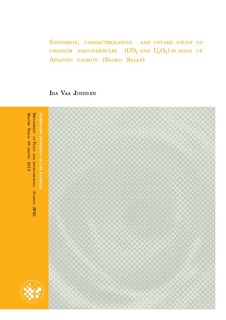| dc.description.abstract | Abstract
The use of nanomaterial, nanotechnology and the awareness of nanoparticles (NPs) in the environment have escalated in recent years. Uranium (U) is an element frequently used and released to the environment, being the major fuel material used in nuclear energy power plants. The study of U NPs is, however, rather scarce in literature, although studies of micro sized particles have been carried out. Since U NPs occur both naturally and can be synthesized as catalysts, this was the focus of the present thesis. Work included the synthesis of U NP, the characterization of these particles and the use of these U NPs, as well as U ions, in an uptake study in fertilized eggs of Atlantic salmon (Salmo salar).
Two different kinds of U oxide NPs were successfully synthesized from uranyl acetate dihydrate with depleted uranium (DU). These particles were synthesized by modifying a method previously used by Wang et al. (2008), using organic amines as reducing agents under hydrothermal conditions in a high pressure microwave (UltraClave). The product was washed with ethanol, half was freeze-dried whereas the other half was subjected to dialysis and subsequently kept in suspension. Observations in transmission electron microscopy (TEM) showed that purification of synthesized products by means of dialysis (mean diameter 85 nm for the U3O8 suspension and 198 nm for the UO2 suspension) yielded smaller sized NPs than subsequent freeze-drying (mean diameter 530 nm for the U3O8 suspension and 220 nm for the UO2 suspension). From these images it was also evident that the dialysis treated suspensions contained more single small particles (~<50 nm) than the freeze-dried suspensions, where almost all the U particles are in aggregates. This is possibly the result of the product being kept in suspension during all times when treated with dialysis, as opposed to freeze-drying. More than 50 % of the particles in each suspension treated with dialysis had diameters between 1-100 nm; both suspensions could hence be defined as nanomaterial according to the European Commission’s definition.
In the uptake study, eggs were exposed to uranyl, UO2 and U3O8 suspensions; all containing ~ 50 mg/l U. The exposure took place during 24 hours after dry fertilization, and then transferred to clean water for 1 week of depuration. Fish eggs were sampled after 3 and 24 hours exposure to U and after 3 and 7 days in clean water. In addition, samples of the eggs interior was taken, using a syringe, at each sampling point. The U concentration in eggs was determined by ICP-MS (both whole eggs, and interior), as well as in water samples taken before and after exposure, and after 3 and 7 days of depuration in clean water. In addition to total water samples, samples collected before and after exposure, was fractionated using 0.2 µm syringe filters, high speed centrifugation (30 000 rpm; ~93 000 g) and 3 kDa membrane filters. Uranium concentration was measured in all fractions, and some were analyzed by TEM, to determine the particle distribution, and to identify whether the organic matter in the water had changed the U size distribution.
It was found that eggs exposed to U NP’s contained much U on the exterior shell, while the concentration of U in the interior of eggs exposed to uranyl was higher than in those exposed to U NP. Most of the U measured in the whole eggs exposed to NP’s was present on the egg shells already after 3 hours exposure, and the concentration of U did not decrease noticeably during depuration. The conclusion is therefore that U ions are more bioavailable to the fish eggs than U NPs. The U concentration did, however, decrease faster during depuration in fish eggs exposed to uranyl, than in fish eggs exposed to U NP.
From both the TEM images and the ICP-MS measurements, it was evident that more U in the water was present as HMM species after exposure than before. This led to the conclusion that either organic matter, or time, induced the formation of U particles in U suspensions. When comparing TEM images taken of total water fractions and <0.2 µm water fractions, it was evident that there was some clogging in the 0.2 µm filter, since particles with diameters lower than the filter pore size cut-off were retained by the filter. This also led to an underestimation of small sized U particles in the suspension. | no_NO |
